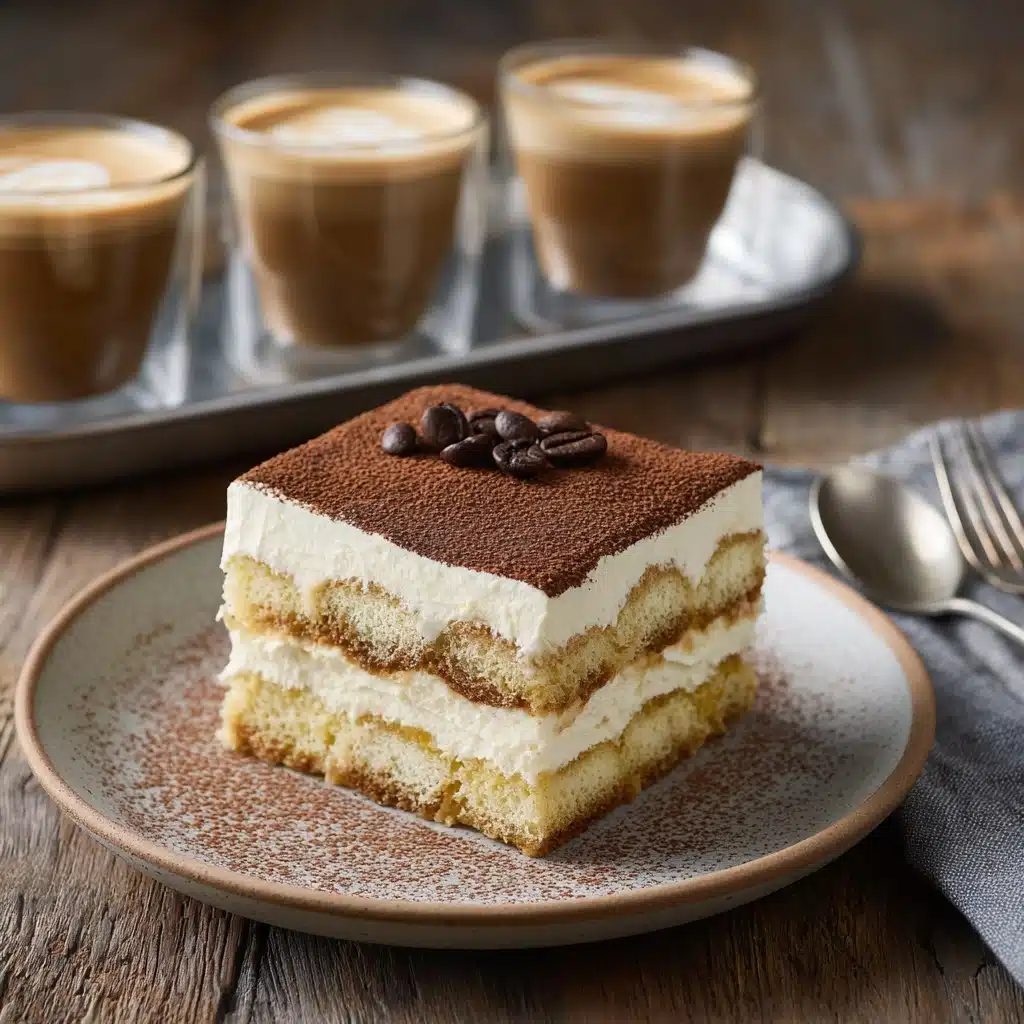If there’s a dessert that perfectly balances coffee richness, creamy layers, and a touch of decadence, it’s the Classic Tiramisu with Espresso. This beloved Italian treat marries silky mascarpone with coffee-soaked ladyfingers, all topped with a dusting of cocoa and (if you’re feeling extra fancy) shavings of dark chocolate. Whether you’re hosting a dinner party or simply craving something special, this recipe offers a luscious bite of Italy in every forkful, and it’s honestly a dish I can never resist sharing.
Ingredients You’ll Need
Ingredients You’ll Need
You might be surprised by how just a handful of classic ingredients can transform into something utterly divine. Each element plays a special part in building that iconic flavor and dreamy texture you love, so let’s give them each a moment in the spotlight.
- Egg Yolks: The rich, silky base of the mascarpone cream, adding both color and luxurious texture.
- Granulated Sugar: Sweetens and stabilizes the egg yolks as they’re whisked, creating a thick, pale custard.
- Heavy Cream: Whipped to soft peaks, this makes your tiramisu filling pillowy and light.
- Mascarpone Cheese (room temperature): The heart of Classic Tiramisu with Espresso, bringing unmatched creaminess and subtle tang.
- Brewed Espresso or Strong Coffee (cooled): Soaks into the ladyfingers, infusing the dessert with bold coffee notes – freshly brewed is best!
- Coffee Liqueur (optional): Adds extra depth and a little grown-up twist; totally delicious but skippable if you prefer.
- Ladyfinger Cookies (Savoiardi): These crisp Italian biscuits soak up the coffee perfectly without turning soggy.
- Unsweetened Cocoa Powder: A classic finish, offering a bittersweet balance to the sweetness below.
- Dark Chocolate Shavings (optional): For extra flair and lovely texture—who could say no to a little extra chocolate?
How to Make Classic Tiramisu with Espresso
Step 1: Prepare the Egg Yolks and Sugar
Start by combining your egg yolks and granulated sugar in a heatproof bowl. Set the bowl over a pot of simmering water, making sure the bottom doesn’t touch the water. Whisk constantly (and yes, this part smells amazing!) for about 5 to 7 minutes, until the mixture thickens and turns a dreamy pale yellow. Take it off the heat and let it cool—this creates the rich base that gives Classic Tiramisu with Espresso its signature flavor.
Step 2: Whip the Heavy Cream
In a separate bowl, whip your heavy cream until stiff peaks form. This will add a light, airy texture to your mascarpone mixture, making every bite incredibly smooth and luscious. Give the cream a quick fold to check the peaks—if they stand up without collapsing, you’re ready to go!
Step 3: Combine Mascarpone and Egg Yolk Mixture
Place the mascarpone cheese in a large bowl and use a spatula or electric mixer to beat it until totally smooth. Once the egg yolk mixture is cool, gently fold it into the mascarpone, being careful not to deflate that lovely creaminess you’ve created. This is the heart of your Classic Tiramisu with Espresso, so take your time and enjoy the process.
Step 4: Incorporate the Whipped Cream
Now, fold the whipped cream into your egg and mascarpone mixture. Use a gentle, sweeping motion to keep the mixture light and airy. You’re looking for a fully combined, cloud-like filling that holds its shape.
Step 5: Prepare the Espresso Soak
In a shallow dish, combine your cooled brewed espresso (or strong coffee) with the coffee liqueur if you’re using it. Gently stir together and get ready for the ultimate flavor infusion. The cooled espresso ensures your ladyfingers soak up all that rich flavor without getting too soft.
Step 6: Dip and Layer the Ladyfingers
Take each ladyfinger and quickly dip it into the espresso mixture. Don’t linger—just a quick dunk on each side so they absorb the coffee but don’t fall apart. Arrange a layer of dipped ladyfingers in the bottom of your 9×9-inch dish, snug but not squashed. This forms the foundation for your Classic Tiramisu with Espresso.
Step 7: Add Mascarpone Layers and Repeat
Spoon half of the mascarpone mixture over your first layer of ladyfingers, spreading it gently to the edges. Repeat with another layer of dipped ladyfingers, then finish with the remaining creamy mascarpone on top. Smooth it out, cover, and pop the dish in the fridge for at least six hours—or overnight if you can wait! This chilling time allows all the flavors to meld beautifully.
Step 8: The Final Flourish
Just before serving, dust the top evenly with unsweetened cocoa powder and, if you like, scatter over some dark chocolate shavings. The finished Classic Tiramisu with Espresso should look invitingly soft, with a hint of romance from the cocoa topping.
How to Serve Classic Tiramisu with Espresso
Garnishes
Dusting the top with unsweetened cocoa powder is more than tradition—it adds a bittersweet note that brings out the espresso and mascarpone richness. For extra flair, sprinkle dark chocolate shavings or even a few chocolate-covered espresso beans. If you’re serving guests, a fresh mint sprig or a couple of raspberries on each plate can add a lovely pop of color.
Side Dishes
Classic Tiramisu with Espresso pairs excellently with fresh berries for a refreshing, tart contrast. You could also serve it alongside a scoop of vanilla gelato for a chilled, creamy touch, or offer it at the end of a meal with a cup of rich Italian coffee or a glass of dessert wine like Vin Santo.
Creative Ways to Present
For a playful twist, assemble individual tiramisus in small glasses, mason jars, or even espresso cups—perfect for parties or easy portion control. If you want to get fancy, try layering the dessert in a trifle bowl, or cut neat squares and serve on decorative plates with chocolate drizzles for an elegant finish.
Make Ahead and Storage
Storing Leftovers
Leftover Classic Tiramisu with Espresso should be stored in the refrigerator, tightly covered with plastic wrap or a lid. It’s best enjoyed within 3 to 4 days, as the ladyfingers get softer over time, but the flavor actually deepens as it sits. Always use a clean utensil to serve to keep it fresh as long as possible.
Freezing
You absolutely can freeze tiramisu! Wrap the whole dish (or portions) tightly in several layers of plastic wrap and then foil. Freeze up to 2 months. Thaw overnight in the refrigerator before serving—just note the texture may soften a touch, but all the rich flavors remain.
Reheating
Tiramisu is a no-bake, chilled dessert, so there’s no need to reheat! Simply slice and serve it straight from the fridge, dusting the top with additional cocoa powder if needed to freshen up its gorgeous appearance.
FAQs
Can I make Classic Tiramisu with Espresso without alcohol?
Absolutely! The coffee liqueur is optional, so you can skip it without sacrificing flavor. The espresso alone provides all the authentic coffee notes that make this dessert so irresistible.
What’s the best coffee to use for Classic Tiramisu with Espresso?
Go for a strong, freshly brewed espresso if possible, but any robust, high-quality coffee will do. Just make sure it’s cooled before dipping the ladyfingers so they don’t get mushy.
Do I need to use pasteurized eggs?
It’s a good idea, especially if you’re serving young children or anyone with health concerns. The double boiler (bain-marie) method helps cook the yolks, making this recipe safer to enjoy for everyone.
Why does tiramisu need to chill for so long?
Chilling Classic Tiramisu with Espresso for at least six hours (or overnight!) lets the coffee flavors infuse and the creamy filling set. Patience pays off here—each slice will be perfectly sliceable and filled with layered flavor.
Can I use something other than ladyfingers?
While savoiardi are traditional, you can substitute sponge cake or even pound cake in a pinch. The key is to use a light, airy baked good that can soak up the espresso without going soggy.
Final Thoughts
Classic Tiramisu with Espresso is more than just a dessert—it’s an experience worth savoring with friends and family. Each bite is a reminder that simple ingredients and a thoughtful touch can create pure magic. Give this recipe a go, and you’ll see just how easy it is to bring a slice of Italy’s sweet spirit right to your kitchen table!
PrintClassic Tiramisu with Espresso Recipe
Indulge in the rich and creamy delight of a classic tiramisu with espresso. This no-bake Italian dessert features layers of coffee-soaked ladyfingers and a luscious mascarpone cream, finished with a dusting of cocoa powder and optional chocolate shavings.
- Prep Time: 30 minutes
- Cook Time: 10 minutes
- Total Time: 40 minutes (plus chilling time)
- Yield: 8 servings 1x
- Category: Dessert
- Method: No-Bake
- Cuisine: Italian
- Diet: Vegetarian
Ingredients
Egg Mixture:
- 6 large egg yolks
- 3/4 cup granulated sugar
Cream Mixture:
- 1 cup heavy cream
- 8 ounces mascarpone cheese (room temperature)
Assembly:
- 1 1/2 cups brewed espresso or strong coffee (cooled)
- 3 tablespoons coffee liqueur (optional)
- 24 ladyfinger cookies (savoiardi)
- Unsweetened cocoa powder (for dusting)
- Dark chocolate shavings (optional)
Instructions
- Prepare the Egg Mixture: In a heatproof bowl over simmering water, whisk egg yolks and sugar until thickened and pale, about 5-7 minutes. Remove from heat and cool.
- Whip the Cream: In a separate bowl, beat heavy cream until stiff peaks form.
- Mix Mascarpone Cream: In a large bowl, beat mascarpone until smooth. Gently fold in the cooled egg mixture, then fold in the whipped cream until smooth.
- Assemble Tiramisu: Dip ladyfingers in espresso mixture and layer in a dish. Spread half of mascarpone mixture over ladyfingers. Repeat layering, then refrigerate for at least 6 hours.
- Serve: Dust with cocoa powder and chocolate shavings before serving.
Notes
- Use pasteurized eggs or a double boiler method for food safety.
- Tiramisu is best made a day ahead to develop flavors fully.
Nutrition
- Serving Size: 1 slice
- Calories: 420
- Sugar: 18g
- Sodium: 70mg
- Fat: 28g
- Saturated Fat: 17g
- Unsaturated Fat: 9g
- Trans Fat: 0g
- Carbohydrates: 32g
- Fiber: 1g
- Protein: 6g
- Cholesterol: 195mg




